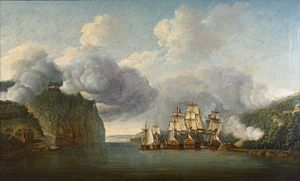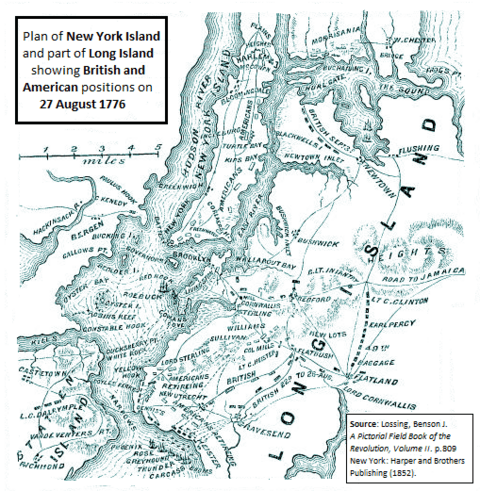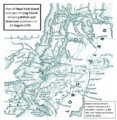HMS Roebuck (1774) facts for kids
HMS Roebuck was a British Royal Navy warship. It was a "fifth-rate" ship, meaning it was a medium-sized warship. Roebuck played an important role in the American Revolutionary War and the French Revolutionary War. It was designed to sail in the shallower waters of North America.
The ship joined Lord Howe's fleet in 1775. It took part in battles around New York in 1776. Roebuck helped attack American forts and ships. Later, it became a hospital ship and then a troopship. The ship was finally taken apart in 1811.
Contents
Building and Weapons of the Roebuck
Roebuck was the first of its kind, a new type of warship. It had two decks and was built for shallow waters. Famous ship designer Sir Thomas Slade created its plans in 1769. The British Navy ordered the ship on November 30, 1769. Its main frame, called the keel, was laid down in October 1770. This happened at Chatham Dockyard.
The ship was about 42.7 meters (140 feet) long at its main gun deck. It was about 11.5 meters (37 feet 9.5 inches) wide. The ship was launched on April 24, 1774. It was finished by August 4, 1775. Building and fitting out Roebuck cost about £20,660.
Roebuck had two rows of windows at the back. This made it look like it had an extra deck. But it only had one large cabin there. This design was later changed for other ships of its class.
The ship carried many guns. On its lower deck, it had twenty 18-pounder guns. On its upper deck, it had twenty-two 9-pounder guns. These were later made stronger to 12-pounder guns. It also had two 6-pounder guns at the front of the ship. The back deck had no weapons. When fully staffed, Roebuck had a crew of 280 to 300 sailors and officers.
Roebuck at War
Fighting in the American Revolutionary War
Captain Andrew Snape Hamond first took command of Roebuck in July 1775. The ship sailed to North America in September. It joined Lord Howe's fleet. They took part in battles around New York the next year.
On March 25, 1776, Roebuck got stuck in shallow water. This happened off Cape Henlopen. Luckily, the ship was not damaged. Its crew quickly got it free. The next day, Roebuck captured a small American schooner. Its smaller boats also caught two sloops. On March 28, Roebuck captured another sloop.
Roebuck was part of the Battle of Long Island on August 27, 1776. It attacked American gun forts at Red Hook. On October 9, it fought on the Hudson River. With two other British ships, it destroyed two armed American boats. They also sailed past and attacked Fort Washington and Fort Lee. Between March and December 1776, Roebuck helped capture or destroy at least 23 enemy ships. In April 1777, it captured two American warships. These were the 14-gun Defence and the 10-gun USS Sachem.
In August 1777, the British planned to land an army in Maryland. Their goal was to capture Philadelphia. Captain Hamond knew the local waters well. So, Roebuck was chosen to guide the British fleet. On August 25, Roebuck and other ships escorted troop transports. They landed the army about 10 kilometers (6 miles) from Turkey Point.
Attacking Philadelphia
The British captured Philadelphia on September 26. But they needed to control the Delaware River to get supplies. The Americans had blocked the river with forts and obstacles. Captain Hamond offered to clear a path at Billingsport. British soldiers captured the fort there. Then, Roebuck's crew made a 2.1-meter (7-foot) opening in the river blockades. This allowed Roebuck and other ships to pass through.

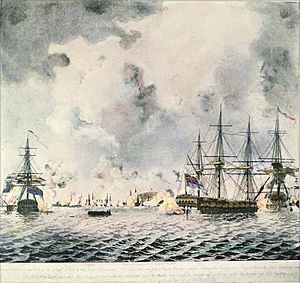
The British ships faced heavy fire from American boats. Two British ships, Augusta and Merlin, were destroyed. Roebuck and the other ships had to retreat. The British still needed to open the river. They built gun batteries on Province Island. After six days of bombing, the Americans left Fort Mifflin. Then Fort Mercer also fell. This allowed the British to control the river.
In July 1778, Roebuck was near Sandy Hook. In August, it fought against a French fleet. France had joined the war on the American side. A big storm scattered the fleets. Roebuck lost a mast. It was ordered to escort another damaged ship, Apollo, to Sandy Hook.
Roebuck captured an American privateer (a privately owned warship) in February 1779. Then it went to Woolwich Dockyard for repairs. Its hull was covered in copper to protect it. This work finished in April.
Battles around Charleston
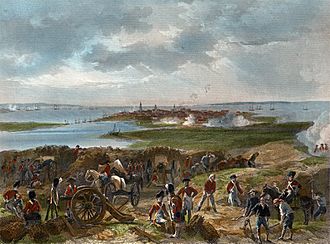
Roebuck returned to America by December 1779. It captured another American privateer, Lady Washington. Then, it joined a fleet carrying 7,550 soldiers to attack Charleston. The ships left New York on December 26. In January 1780, they stopped in Savannah for repairs. The army landed near Charleston on February 10. The ships then blocked Charleston harbor.
Admiral Marriot Arbuthnot made Roebuck his main ship. Larger British ships could not enter the shallow harbor. So, Roebuck led the attack on April 9. It sailed across a sandbank and faced heavy fire from Fort Moultrie. The British ships suffered damage and lost 27 men. Roebuck continued to James Island. It was hit by cannon fire from Charleston but did not fire back.
American naval ships retreated up the Cooper River. Some were sunk by their own crews. This stopped the British from controlling that river. On May 7, British sailors and marines landed near Mount Pleasant. They captured a fort and forced Fort Moultrie to surrender. Some of Roebucks crew helped in these land battles. Charleston surrendered on May 11. Roebucks crew received money for capturing two American frigates. Captain Hamond left for England. His nephew, Andrew Snape Douglas, took command.
Blockading Enemy Ships
In January 1781, Roebuck was not with the fleet during a big storm. The British were blocking French ships in Newport. Admiral Arbuthnot learned that French ships had left Rhode Island for Virginia. He sent a ship to find Roebuck and other British ships. But the message arrived too late. A French squadron captured the British ship Romulus.
On April 14, 1781, Roebuck and another ship captured the 36-gun American frigate USS Confederacy. This ship was carrying supplies for the American army. It was taken into the Royal Navy as HMS Confederate. The next month, Roebuck captured another American frigate, Protector. Captain Douglas was replaced by Captain John Orde in July. Roebuck then sailed to Europe with Admiral Arbuthnot. It briefly returned to America and captured a French privateer in February 1782. Roebuck finished its war service in the North Sea and was taken out of service in April 1783.
French Revolutionary Wars
After the American war, Roebuck was repaired at Sheerness. This cost over £11,000 and took until February 1785. In June 1790, Roebuck became a hospital ship. It served in this role during the war with France. In March 1794, it was part of the fleet that captured Martinique. British forces landed on Martinique on February 5. By March 16, they controlled most of the island. Sailors and marines from the fleet helped capture the main town and forts. Martinique surrendered by March 22. The British then captured St Lucia and Guadeloupe. In May 1796, Roebuck returned to help retake St Lucia.
Anglo-Dutch War
In 1795, France took control of the Dutch Republic. This led to a war between Britain and the new Dutch government. Roebuck was serving in the Leeward Islands. On July 6, 1797, it captured a Dutch privateer called Batave. In February 1798, it captured two more ships, William and Betsey. On February 19, it captured a French privateer, Parfait.
In November 1798, Roebuck went to Deptford. It was refitted as a troopship for £10,044. It was ready for service again in July 1799.
Roebuck joined a fleet for the Anglo-Russian Invasion of Holland. This fleet was led by Vice-Admiral Sir Andrew Mitchell. On August 30, 1799, the Dutch fleet surrendered without a fight. Two days before, the British fleet had captured four Dutch ships. British troops landed in Holland on August 27. They captured forts and ships. Mitchell's fleet entered the Vlieter on August 30. The Dutch fleet surrendered there.
On November 12, 1799, Roebuck arrived in the Downs. It carried 500 soldiers from Holland. In January 1800, Roebuck sailed to Cork, Ireland, with more soldiers. It returned to England in March. In April, it left with a convoy for the Downs.
Between March and September 1801, Roebuck was involved in battles in Egypt. Because of this, its crew later received a special medal.
Napoleonic Wars
The Treaty of Amiens brought peace in March 1802. Two months later, Roebuck was taken out of service. It was stored at Woolwich Dockyard. But the peace did not last long. War started again in May 1803. In July, Roebuck was brought back as a guardship at Leith. It served as the main ship for Vice-Admiral Richard Rodney Bligh and Rear-Admiral James Vashon. It later moved to Great Yarmouth.
In March 1806, it became a receiving ship. This meant it was used to house new sailors. In 1810, it became the main ship for Lord Gardner. Finally, Roebuck was taken apart at Sheerness Dockyard in July 1811.
Images for kids
-
British chart showing American defences on the Delaware in 1777. Roebuck is shown attacking a battery opposite Hog Island before travelling up the river to engage the American fleet
-
Roebuck (forefront, far right) at the action off Mud Fort on 15 November 1777


